News
Dive Notes from a Small Island: Part 3 – Ireland & Northern Ireland

Having heard many great things about the diving in both Ireland and Northern Ireland and having the whole of August still ahead of us, we thought it would be rude not to go and investigate the diving on our neighbouring island of Ireland. Setting off from Holyhead on Sunday (sadly no diving in north Wales due to the weather, again!), we arrived in Dublin for some pints of Guinness and some city sightseeing. On the Monday we began our scenic tour around the wild Atlantic way, exploring the Irish countryside. Ireland is stunningly beautiful, if a little windy, and we got a lovely weather window for diving with Scubadive West, in County Galway.
Dive 7: Scubadive West house reef (“The 60 Footer”)

Site description:
Scubadive West is located in the stunning Little Killary Fjord. The dive center is well equipped and has friendly and informative staff, the house reef is accessible via the dive shop slipway and costs €10 per diver for access (boat dives are available on the weekends).
The house reef starts at the slipway which leads into a small sandy area sheltered by the kelp covered rocks, a channel in the rocks leads to “The 60 Footer” wreck, 30m out on a heading of 40°. The wreck is a 19m long, 6m wide wooden hulled former mussel tender and fishing vessel which sank while under tow in 2011. It now lies in 17m in the Little Killary Fjord and is covered in spectacular amount of life. After a thorough look around the wreck it is possible to continue along a line from the bow to some old scaffolding, which has huge numbers of tube worms growing on it. From here you can backtrack to the wreck and take a 270° heading back to the reef. Once beside the reef there are some old scuba cylinders with lobsters hiding in them, keeping the reef left, swim round the kelp covered rocks, over a small seagrass patch and back to the sandy area in front of the slipway to surface.
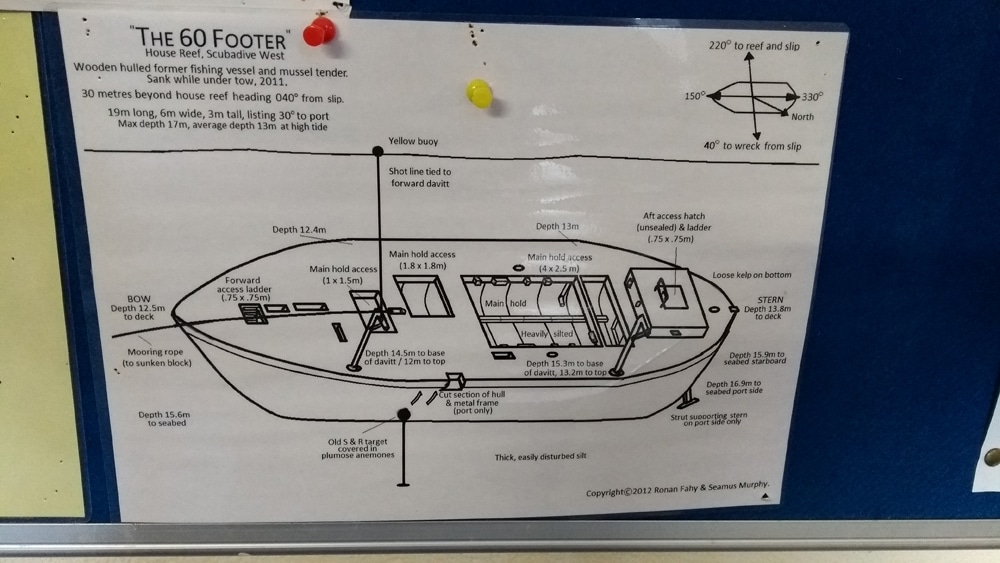
The Dive:
We arrived just after low tide and were joined by a keen young diver, Magnus, who was familiar with the shore dive and offered to guide us round. We waded out on the sand patch and did a surface swim over the shallow kelp covered rocks to the far side of the reef until we had a few meters depth to make our descent. The visibility was much better than any of our dives so far and we were very pleasantly surprised by the amount of life immediately visible on the sandy, silty bottom, such as long legged spider crabs, burrowing anemones and a thornback ray. The wreck was at about 14m and covered in life, huge plumose anemones, dead men’s fingers, crabs, lobsters, a shy conger eel and a sleeping dogfish. We explored the wreck and then headed over to see the organ pipe worms on the scaffolding, which were incredibly prolific and colourful. The rest of the dive was spent bimbling round the shallows near the reef looking for macro life, like the sea lemon nudibranch, pipefish, butterfish and a Yarrell’s blenny. Magnus was a great guide and I thought 75 minutes went by incredibly fast with so much to see. This is one of the best shore dives I have done in temperate waters!

Mike’s thoughts:
I had high expectations of diving in Ireland and this site did not disappoint. Much like our shore dives at Porthkerris in Cornwall, entry and exit were very convenient with parking and a full service dive center just meters from the shore. For an easy temperate water shore dive, the variety and abundance of life here was truly outstanding. From the scallops, crabs, gobies and dragonets in the sandy bottom to the anemones and tubeworms on the structures hardly a minute went by without something new to look at. I was especially happy to see my first dogfish up close as well. The only way to improve our dive for me would have been to wait for the tide to be a bit higher so that we could have seen more of the seagrass and kelp beds just off of the shore. As it was, I did manage to spot a pipefish in the seagrass on our way back in. With this much life right off the shore, I could only wonder at how much else there must be to see at the 50+ dive sites in the local area.
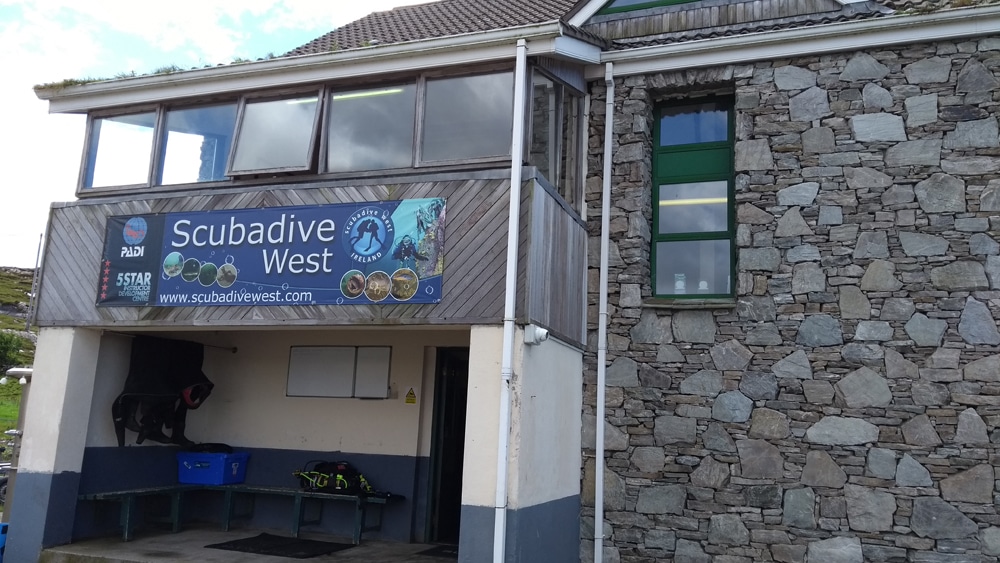
After being thoroughly impressed by Ireland’s diving we headed to Northern Ireland to do a boat dive on Rathlin Island with Richard at Aquaholics. The north coast is stunning with many National trust sites and Mike and I found ourselves getting very excited about the next days diving when we arrived and caught sight of Rathlin Island for the first time. On the morning of the dive we met at Ballycastle marina and got onto the Aquaholics catamaran and were introduced to our fellow divers. With some swell and a spring tide our first dive was on the sheltered south side of the island, before heading round to the wall on the north.
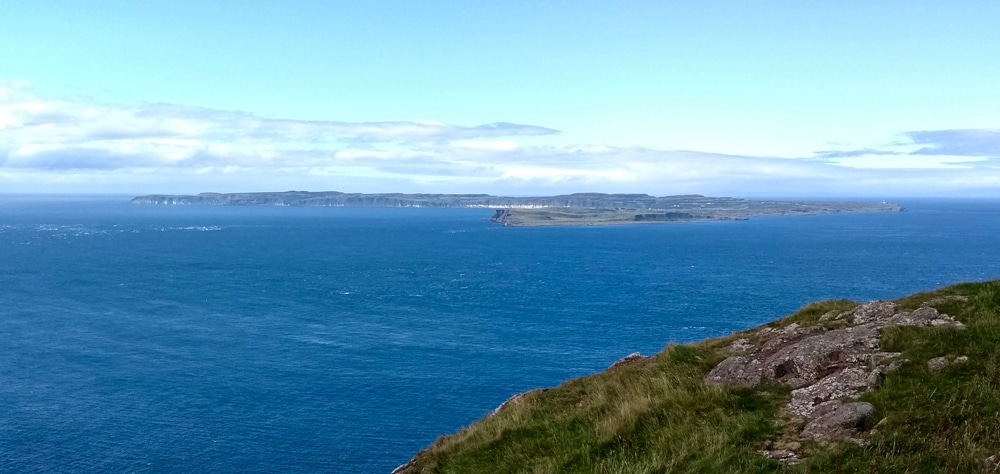
Dive 8: Sronlea Head, Church Bay, Rathlin Island
Site description:
Tucked in against the sheltered south facing cliffs the first dive of the day was on a rocky reef characterised by a sloping rock and boulder reef, covered in kelp down to 12m. The slope then continued gently down to 30+m, with the area known for having rich macro life and some rare species not found outside of this area.
The Dive:
The dive was planned as a gentle drift with the tide and on our descent through the kelp we found there was little current and we made our way down to about 22m based on the recommendation of our skipper Richard. It was a fantastic dive with excellent visibility and vast amounts of macro life, that had us stopping every meter to photograph a new nudibranch or cup-coral. We didn’t even make it to the main part of the dive site as we were so wrapped up in spotting all the life on the rocks and I spent a very enjoyable 55mins geeking out on this incredible site.

Mike’s thoughts:
The visibility for our dive was great and I enjoyed our relaxing drift along the rubbled slope. Although not quite as easy to spot as their brightly-colored tropical cousins, the nudibranch life in this area was definitely a highlight for me. We managed to spot five different species on the dive, which I thought was nice considering we only drifted for about 100 meters from the drop off point. I was also happy that my critter-spotting eyes were improving. The greenish waters all around the UK and Ireland make the general panorama a bit monochrome, so you really have to train your eyes to adapt and a learn a bit about various creatures’ preferred habitats to appreciate all of the life that is present. A dive torch is a necessity and I was quite lucky to have my friendly torch-wielding, critter-spotting buddy along.
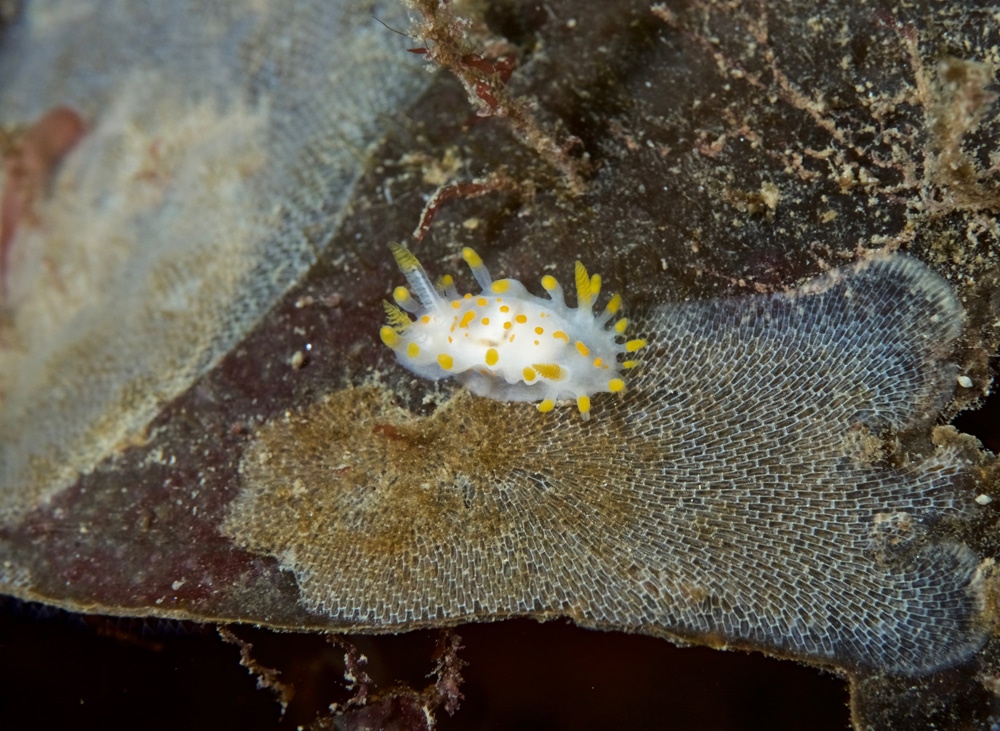
Dive 9: Pinnacle, Farganlach Point, Rathlin Island
Site description:
The north side of Rathlin island is known for is deep walls that go from a few meters down to over 100m. The north has shallow gullies and pinnacles going down onto the main wall and after the first 16m of kelp covered rock the walls become sheer and are covered in a huge amount of life all the way from the kelp line at 18m to the depths.
The Dive:
We waited for slack tide (a must on spring tides) and entered the water on the pinnacle. After dropping down about 18m we found the kelp stopped and the wall began. Despite the slack tides, the currents were having a party up, down and sideways on the wall and so we took the excellent advice of our skipper and stuck close to the wall to avoid the worst of it. The visibility was good again and the walls absolutely packed with life, dead men’s fingers, jewel anemones, white striped anemones, Devonshire cup-corals and a variety of sponges covering every inch of rock. We also had a visit by a compass jellyfish, albeit briefly, which rocketed up past us in the current. We had a good dive, sticking to the wall and moving gently along with the flow. The diving here is excellent and definitely lived up to it’s reputation!
Mike’s thoughts:
The diving potential in this area seems enormous, with seven miles of sheer walls to explore; in our case I’m glad we stayed fairly shallow and within a small area of the drop off point. While not quite approaching a washing machine, the currents throughout the dive were strong and constantly changing making buoyancy control very challenging. Nevertheless, by hugging the wall closely we could enjoy inspecting the life on the wall as we drifted by. Again, the density of life was impressive with a wide variety of creatures from tiny cup corals to large lobsters packed into every nook and crevice. The huge shoals of pollock and coley streaming by us were more evidence of just how nutrient-rich the local waters were. The conditions on our dive were definitely for more experienced divers but I thoroughly enjoyed my introduction to boat diving in Northern Ireland!
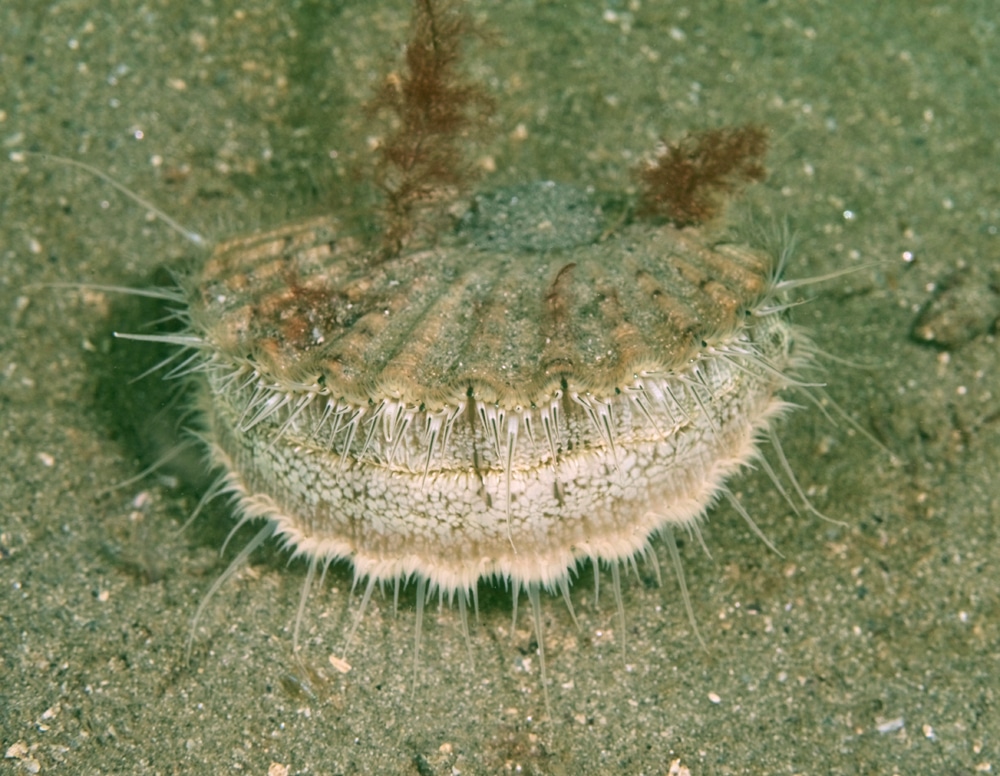
News
UWACAM Impresses at BOOT 2025 with New App

BOOT 2025, the world’s largest water sports trade fair, provided the perfect stage for the launch of the new UWACAM app which meanwhile is rated at an excellent 4.8 out of 5 in the Apple App Store.
Optimized for DIVEVOLK (divevolkdiving.com) Seatouch housings and developed in collaboration with award-winning underwater filmmaker Matthias Lebo (matthiaslebo.com), this app is user-friendly and features large, clear controls, enabling effortless and stunning shots.
It offers professional functions typically found in high-end cameras, supports the LOG format for advanced color corrections, includes built-in LUTs (Color Lookup Tables) to restore underwater colors, and provides a manual mode, user presets, histogram, focus peaking, zebra function, and much more.
As an official product of Bumbayaya GmbH (bumbayaya.ch / uwacam.com), the UWACAM app has been specifically designed for use in DIVEVOLK Seatouch underwater housings. Visitors were able to experience the app live at the DIVEVOLK booth.
UWACAM simplifies underwater photography with an intuitive user interface that is perfectly adapted for underwater operation. The app offers precise control and delivers impressive results for both hobby divers and professionals.

Why UWACAM?
- Specifically developed for DIVEVOLK: Perfect integration into Seatouch housings for effortless underwater operation.
- Simple yet professional: Switch between an Easy Automatic Mode for beginners and a comprehensive Pro Mode.
- All-in-one app: Supports all photo and video formats, including LOG for professional color corrections.
- Pro Features:
- Focus Peaking: Precise focus control.
- Zebra Function: Prevents over- or underexposure.
- Built-in LUTs: Color corrections for realistic underwater shots.
- Manual Controls: Fine-tune exposure, focus, white balance, and more.
- Diver-Specific Features: Automatic color correction based on environment and dive depth, plus an optional magnetic compass overlay.
“We are excited to present UWACAM at BOOT 2025,” says Matthias Lebo, who played a key role in its development. “With UWACAM, we bring the beauty of the underwater world directly into the hands of divers and snorkelers—intuitive, powerful, and adaptable.”
Customer Reviews


Available in the App Store
UWACAM is now available for download in the App Store.
https://apps.apple.com/de/app/uwacam/id6714463099
News
Gear Review: Atomic Blade Fins (Watch Video)

In a video produced exclusively for Scubaverse.com, Jeff Goodman reviews the Blade Fins from Atomic Aquatics.
For more information about products from Atomic Aquatics, visit www.atomicaquatics.com.
Sea & Sea is the home of Atomic Aquatics and other leading diving brands in the UK.
-

 Gear Reviews2 months ago
Gear Reviews2 months agoGear Review: SurfEars 4
-

 Marine Life & Conservation3 months ago
Marine Life & Conservation3 months agoPaul Watson Released as Denmark Blocks Japan’s Extradition Bid
-

 News1 week ago
News1 week agoHumpback Mother and Calf Win Underwater Photographer of the Year 2025
-

 News2 weeks ago
News2 weeks agoGo Diving Show 2025 Exhibitor Showcase
-

 News2 months ago
News2 months ago2-for-1 tickets now available for GO Diving Show
-

 Blogs3 months ago
Blogs3 months agoJeff Goodman Launches Underwater Moviemaker Course with NovoScuba
-

 News3 months ago
News3 months agoDive into Adventure: Limited Space Available for January Socorro Liveaboard Trip with Oyster Diving
-

 News3 weeks ago
News3 weeks agoFilming 360 in The Bahamas















